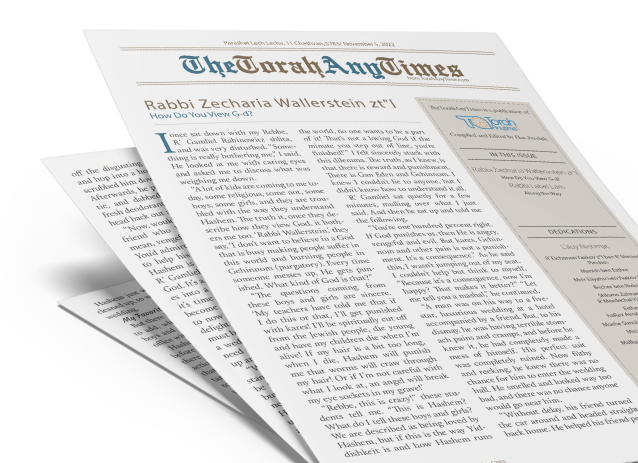|
Mr. Charlie Harary
Embraced by Hashem
One of the more confusing holidays is that of Sukkos. For one, Sukkos commemorates the miracle of the Annanei HaKavod, the Clouds of Glory, which engulfed the Jewish people from the time they left Egypt until they entered the Land of Israel, forty years later. It set the right, comfortable temperature, kept the Jews’ clothing freshly laundered, smoothed out the path before them and protected them from outside danger.
Yet, if the Jews were privileged to enjoy these Clouds of Glory for forty years, starting from when they departed Egypt, why they are we celebrating Sukkos now, after Yom Kippur? Firstly, we should celebrate it around the time we left Egypt, in the month of Nissan. Most other Jewish holidays are celebrated at the time the original miraculous, monumental event took place. Pesach is celebrated at the time the Jews left Egypt; Shavuos is commemorated when the Torah was given; Chanukah is the same. Did the Torah dictate we celebrate Sukkos now simply because it is a time for holidays, given the preceding days of Rosh Hashanah and Yom Kippur? Is there nothing more to this time of year that directs us to celebrate Sukkos?
Moreover, why do we commemorate the miracle of the Annanei HaKavod altogether? They were one miracle, amongst many others, including the Be’er Miriam (Well of Miriam), which we have no celebration of, and the manna, which we also do not commemorate. What is so special about the Clouds of Glory that we one, celebrate it right after Yom Kippur, and secondly, commemorate it altogether over everything else?
Years ago, a friend of mine was undergoing a very difficult time in his marriage. Amidst the rockiness of his relationship, he did something bad, jeopardizing his relationship even further. Once his wife had learned of what he had done, she asked him to leave the house. At that point, their marriage spiraled out of control.
He decided to call me and tell me something that had taken place between him and his wife. “One day, we were sitting with our therapist, and my wife turned to me and said, ‘You know what, I’ve been thinking about it… I forgive you.’ I wasn’t sure if I had heard her correctly. So she elaborated. ‘I want to give you the benefit of the doubt, and I have thought long and hard about it, and I don’t want to hold onto this resentment.’ I was profusely thankful to her. ‘Okay,’ I said. ‘So I’ll see you soon… I’ll move back into the house…’ ‘No,’ she said. I looked at her confused. ‘I don’t understand; I thought you forgive me.’ ‘I forgive you,’ she said, ‘but that doesn’t mean I want to live with you again. I’ve made peace with what’s happened and we’re good, but I still don’t want to live with you anymore regardless of me forgiving you.’”
As I heard this, it dawned on me the incredible distinction between forgiveness and reconciliation. You can forgive somebody and never wish to see them again.
So let’s pull back a little bit. What is Sukkos? It is the end of a massive saga, having begun when the Jews left Egypt and were brought to Har Sinai and given the Torah. Yet what happened just after receiving the Luchos and becoming inextricably bound to Hashem, akin to a husband-wife relationship? We committed the unspeakable; we worshipped the Golden Calf. We served an idol at the foot of Har Sinai.
Moshe, seeing the horrific downfall committed by the Jews, smashed the Luchos, as Hashem looked down at His beloved nation which had strayed and betrayed their relationship. Moshe spent the next forty days attempting to reconcile G-d and the Jewish people. After those forty days, on Yom Kippur, Hashem forgave them.
During those forty days, the Jews had lost the privilege of the Annanei HaKavod. They were without the loving embrace which they were used to. The moment which they learned that Hashem had forgiven then, what did they expect? The Clouds of Glory would return and surround them. But that’s not what happened.
The Jews then had the following thought. “Hashem forgave us, but maybe He doesn’t want to live with us anymore…” For the period following Yom Kippur, the Jews thought, “Uh-oh, we’ve been forgiven, but we want more… We want Hashem back in our life with the Annanei HaKavod… but Hashem doesn’t want us…”
When did the Clouds of Glory return? On the 15th of Tishrei, on the day we begin celebrating Sukkos.
When the Clouds returned, the Jews realized that Hashem had not just forgiven them; He wanted to live with them once again. In contrast to the wife in the above scenario, Hashem wanted to reconnect with the Jewish people. They were now back in His embrace.
No matter what happens in our lives, at our core, we know that when we are in the embrace of Hashem, everything will be okay. This is why the key component of Sukkos is simcha, joy. True joy is when we have G-d intimately a part of our life.
As we enter the joyous days of Sukkos, we ought to remember that our greatest joy in life is not the material possessions we have; it is rather that we have G-d in our life. We are able to be nestled into His embrace and be surrounded by His Clouds of Glory. There is no greater joy than that.
Rabbi Zecharia Wallerstein
The Source of Everything
The king’s favorite pastime was without question hunting. The nearby forest provided a plethora of opportunity for the king to take his mind off the stressors of life and engage in something quite different from his daily routine. But the king was not unaware of the dangers of hunting, and so, he made sure to always take his personal doctor with him on such excursions.
One day, as the king made his way through the lush trees and shrubs on his horse, his finger got snagged in a tree and began throbbing with pain. Hollering for the doctor, the king got off his horse and grabbed hold of his hand with an agonizing cry. The doctor took one look, realized it was a deep cut, and immediately began stitching it up.
The king could do nothing more but panic. “Doctor,” frantically asked the king, “am I going to be alright?” “I’ll do my best,” the doctor replied. “I’m hoping everything will heal and return back to normal.”
A few days later, the king’s finger was swollen and pussy. The king was now even more uneasy and worried, prompting the doctor to administer further treatment to the king, and bandage him up again.
But the king continued to worry, asking the doctor over and over, “am I going to be alright?” “I’ll do my best,” the doctor replied as he did before. “I’m hoping everything will heal and return back to normal.”
Three days later, the king’s finger was so swollen that the doctor saw no other option than amputating the finger. And that is exactly what happened.
But after the king had woken and fully come to terms with what had happened, he was livid. “What did you do to me?” screamed the king at the doctor. Without a moment’s delay, the king ordered for the doctor to be taken to prison, where he would be left to die.
Yet the king by no means wished to relinquish his time spent hunting, and so, a few days later, off went the king all alone. But soon the king realized what a mistake he had made. He was attacked by savages and taken hostage. To the king’s dread, this savage nation believed in human sacrifices, and the king would certainly be a good candidate.
Wrapping the king up with leaves and all sorts of other ceremonial adornments, the king was placed onto a wooden plank and carried to the altar. Chants and hymns were hummed by the native savages, praising the captors of their great catch and readying the king for his sacrifice. Everything was set in place, as the crowd gazed with awe at what was about to happen.
All of a sudden, the savage leader raised his hands and halted the ceremonial chants. He then raised the king’s hand and sent the entire surrounding savage crowd into gasps. No one could believe it. The king was without a finger. He was blemished and could not be offered to the savages’ idol, given his imperfection.
As the savages had no further use for the king, they untied him and set him free. The king took off in a dash, racing for his life from the clutches of death. He ran through the palace gates and headed straightaway to the prison where the doctor remained.
“Doctor! Doctor! Come out; you are a free man! You saved my life!” The doctor, after hearing the king’s story, replied that the king had it all wrong. “Your Majesty, I cannot thank you enough for putting me in prison. Had you not done that, I would have been with you on the hunting trip, and I have all my ten fingers. They would have taken me instead of you and sacrificed me. Therefore, thank you for placing me into the dungeon.”
Just imagine. Here you have a man without a finger and a man thrown into a prison, and they are both thanking each other. Each one of them saved the other person’s life.
Real emunah entails, as in this story, losing a finger and knowing it is good, and being thrown in a dungeon and knowing it is good. The good and bad we experience in life comes from the same one G-d. He is the source of everything.
This is reflected within the words of Shema. “Shema Yisrael Hashem Elokeinu Hashem Echad – Listen, Israel, Hashem is our G-d, Hashem is One.” With this phrase, we express that Hashem, the Name of G-d which represents His compassion and kindness, and Elokeinu, the Name of G-d which signifies His strict judgement and justice, is Echad, all One. It all emanates from the same G-d.
Just look at the king and the doctor. Their biggest frustration was their biggest salvation. It took time for them to realize it, and it may take us time too, but be reassured, light is there amidst all the darkness.
Rabbi Yitzchak Botton
Full Faith, Perfect Partnership
The classic Sefer Tanna D’vei Eliyahu states that one who fulfills the mitzvah of living in a Sukkah becomes “a partner with Hashem in creation.” Ostensibly, this statement is quite cryptic and obscure. In what way do we join with Hashem as partners in creation by simply sitting in the Sukkah?
The Zohar explains that the Sukkah represents emunah, faith. Yet what exactly does this mean? The answer to this will shed light on our earlier question.
On the one hand, in order to succeed in anything in life, we must exert much effort and energy. At the same time, though, we are aware that Hashem runs the world. How do these two ideas synchronize? How can it be that we are meant to put in our own hishtadlus, effort, in life and yet believe that G-d still runs the world?
The answer is just that. Perhaps paradoxically, it is axiomatic in Judaism that our efforts are only the means to bringing down Heavenly blessing and enabling our actions to succeed. We never do anything or everything alone. It is together with G-d that we achieve all that we do in our lives.
The Sukkah brings this point home.
There are several, unique laws that guide our building of the s’chach, roof, of the Sukkah. The s’chach must be made from something which is neither mekabel tumah, receptive to becoming ritually impure, nor classified as a kli, a man-made vessel. It must be something which naturally grows from the ground. In contrast, the walls of the Sukkah have no such limitations. It is permissible to use man-made vessels to construct the walls.
A shelter constitutes both walls and a roof. One without the other provides insufficient shelter. This then points to the underlying Jewish concept of emunah, faith. Emunah is made up of a combination of G-d’s providence and concern with the world and our own input from below. Our efforts and free choice fuse together with G-d’s providence and beget our life.
The Sukkah, with its walls, speak to this emunah, and by extension, to the fusing partnership of Hashem’s providence from Above and our own actions from below. G-d’s overseeing of the world’s affairs and our private concerns is represented by the s’chach above, and our efforts are symbolized by the walls below, which extend and meet the s’chach.
This phenomenon lends further insight into a unique halacha noted at the beginning of Mesechta Sukkah (2a). If the walls of the Sukkah do not reach the s’chach, the Sukkah is deemed invalid.
We can now appreciate this halacha from a new perspective and understand why it is problematic. If a person’s efforts, represented by the walls of the Sukkah, do not come in contact with the s’chach, or Hashem, half of the puzzle is missing. If man believes that his own success is all his doing and leaves Hashem out of the picture, he is leaving out a vital component. It is only together with the roof that the walls provide full shelter and constitute a Sukkah. Our actions go hand-in-hand with G-d’s providence, and anything less falls short of being the structure of our life which will breed success.
The Sukkah is thus the perfect epitome of faith in Hashem, and an apt description of our partnership with Him in creating our life in this world.
|


